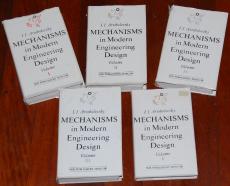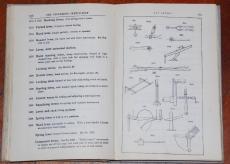Designing mechanisms
They’re rare but if you look long enough you’ll find some.
What I am referring to are books that show just mechanisms. These are the basic underpinnings of all machines, distilled down to their elements. Things like all the ways in that shafts can be joined; all the ratchet systems ever invented; all the ways in which variable ratio gears can be enacted; 2-link, 3-link, 4-link mechanisms; and so on.
 One of the best on the topic is Mechanisms in Modern Engineering Design, a five-volume series written by I. I. Artobolevbsky and published by Mir Publishers of Moscow. Publication date was 1976, making it one of the few engineering books published in Soviet Union times that gained widespread popularity in the West. Well, ‘widespread popularity’ is of course a relative term – the books are still very rare.
One of the best on the topic is Mechanisms in Modern Engineering Design, a five-volume series written by I. I. Artobolevbsky and published by Mir Publishers of Moscow. Publication date was 1976, making it one of the few engineering books published in Soviet Union times that gained widespread popularity in the West. Well, ‘widespread popularity’ is of course a relative term – the books are still very rare.
I have the set, purchased on eBay at great expense.
The books have proved so useful – especially in a ‘food-for-thought’ way – that when I saw another, similar, book on eBay I bought it. And this one was quite cheap.
 It’s called The Engineer’s Sketch Book and it’s by Thomas Walter Barber. Publication date is 1934. The subtitle gives you a feel for the contents: Mechanical movements, devices and details – with nearly 3000 designs and drawings classified and arranged for easy reference.
It’s called The Engineer’s Sketch Book and it’s by Thomas Walter Barber. Publication date is 1934. The subtitle gives you a feel for the contents: Mechanical movements, devices and details – with nearly 3000 designs and drawings classified and arranged for easy reference.
Chapter headings include everything from Ball and Socket Joints to Turbines, from Winding Apparatus to Mincing, from Ratchet and Pawl Motions to Springs. Like the Artobolevbsky volumes, it’s an absolute Godsend for someone groping their way towards the design of a mechanism required to achieve a particular outcome.
But what put a smile on my face was the Introduction to the second edition. Writes Mr Barber:
In view of the criticism of this work which has occasionally found expression by certain readers, who appear to have expected to find in it designs of Machines, Structures, etc., and complaints, based on the same misunderstanding, that the book is, consequently, not kept up to date, the Author has thought it desirable to append a few explanatory observations.
These impressions it may be stated arise from a complete misunderstanding of the intention of the Author and the purpose of the book.
This work is not a treatise on Design, nor a textbook on Mechanical Construction. Its object is to supply the designer with the basic elements of mechanical and structural composition, classified and displayed in such a way as to facilitate the selection of those details which may be most efficiently combined into an effective and harmonious whole.
And so on goes the author, obviously writing through gritted teeth! In fact, to avoid any more misunderstandings of his genuinely fabulous book, Mr Barber then takes the reader on a step by step detailed tour of the design of a reciprocating carriage, showing how each part of the design can be developed with reference to the different sections of his book.
If you like designing mechanical devices, keep an eye out for this type of book. But remember Mr Barber’s warning: they’re meant to show lots of different ideas, not do the full machine design for you!

 Julian Edgar, 50, has been writing about car modification and automotive technology for nearly 25 years. He has owned cars with two, three, four, five, six and eight cylinders; single turbo, twin turbo, supercharged, diesel and hybrid electric drivelines. He lists his transport interests as turbocharging, aerodynamics, suspension design and human-powered vehicles.
Julian Edgar, 50, has been writing about car modification and automotive technology for nearly 25 years. He has owned cars with two, three, four, five, six and eight cylinders; single turbo, twin turbo, supercharged, diesel and hybrid electric drivelines. He lists his transport interests as turbocharging, aerodynamics, suspension design and human-powered vehicles.

on December 4th, 2007 at 6:06 pm
Good Morning!
I have used a book during my coursework in Mechanical Engineering, it’s the “Design of Machinery” by Robert L. Norton. The book comes with software as well to design and simulate different types of mechanical linkages. It is a very thorough treatment of the subject, although it may be a bit hard to digest for a non-engineer. Take a look into it anyway, you might find it interesting.
Regards,
Sami